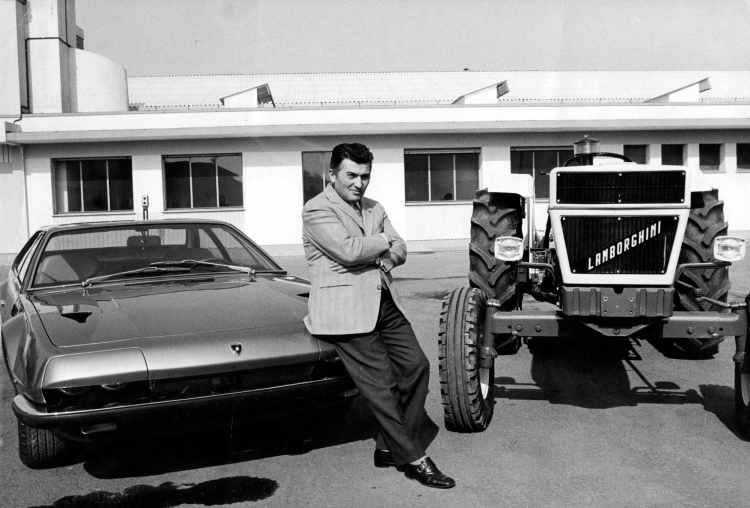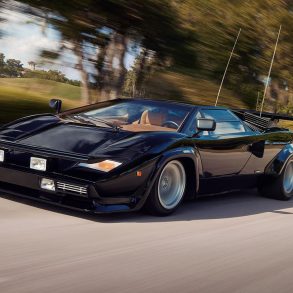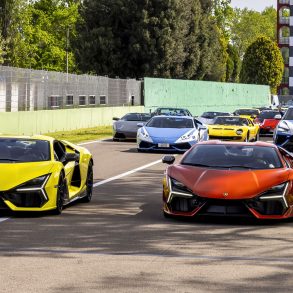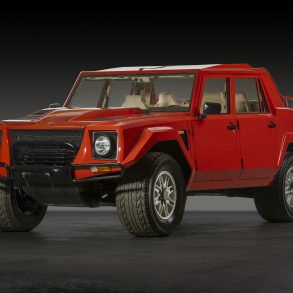April 28, 2021, marks the 105th anniversary of the birth of the founder of Automobili Lamborghini, Ferruccio Lamborghini. Ferruccio was not only instrumental in establishing the company in 1963, but his unrelenting desire to improve and innovate was the inspiration for two of its most iconic models: the Miura and Countach.
Upon the sale of his company in 1973-1974, it had already cemented its position as one of the most admired and most successful manufacturers globally. The company continued his legacy of continuous innovation and challenging itself, a major factor setting the company apart.

On April 28, 1916, Ferruccio Lamborghini was born in a small Italian village, Renazzo di CentoRenazzo, Ferrara. As the eldest son of farmers Antonio and Evelina Lamborghini, it seemed as if he was destined for a life on the farm, given the tradition that the eldest son inherits the family farm. However, young Ferruccio was more interested in mechanics than farming, spending his afternoons in the farmstead workshop.
With similar traits to those born under the zodiac astrological sign of Taurus, Ferruccio was tenacious, strong, and was passionate with his ideas. As a boy, he managed to convince the best mechanical workshop in Bologna to hire him. It was there that he discovered all the secrets of mechanics.
With World War II beginning, Ferruccio was already an experienced and well-known mechanic. He was inevitably drafted into the Italian Royal Air Force and was assigned to the 50th Mixed Maneuver Motor Fleet, stationed in Rhodes. They were responsible for all the maintenance and repairs of the Italian army military vehicles on the island, including tractors and diesel trucks used to tow aircraft.

The changing tides of the war would have Ferruccio repairing and sometimes also breaking, as he recalled, vehicles that belonged to the Germans, Italians, and British. In Rhodes, the young mechanic opened his first company after the war, a small mechanical repair shop.
He returned to Italy in 1946, at the time incentives were being offered to support the country’s economic recovery. Taking advantage of the incentives provided,he opened a machine shop that repaired motor vehicles and built small utility vehicles in Cento.
While working in the shop, he noticed that local agriculture was going through a crisis. He remembered the tractors that he repaired back in Rhodes. It was then that Ferruccio Lamborghini had the idea of building inexpensive tractors that small landowners could afford by using the components of old military vehicles.
The first vehicle he transformed was a Morris truck, with Ferruccio adding a fuel vaporizer that he invented on top of other modifications performed. On February 3, 1948, during the feast of the patron saint of Cento, he presented his creation in town and sold eleven. This initial success fueled Ferruccio Lamborghini into becoming an entrepreneur who risked everything to finance buying 1,000 Morris engines. With his father’s approval, he used his family’s farm as collateral.

The risk paid off handsomely, with Ferruccio Lamborghini making his fortune in tractor manufacturing and becoming one of the most important industrialists in Italy.
In 1958, Ferruccio purchased a Ferrari 250GT (though he would go on to purchasing additional Ferrari vehicles). Unfortunately, according to Valentino Balboni, Lamborghini’s longtime test driver, he was not the best driver and was always burning the clutch. This meant multiple trips to Maranello to replace the clutch.
Instead of having the Ferrari factory replace the clutch, Ferruccio decided to get his head mechanic to replace the clutch after the third or fourth visit to the Ferrari factory. Upon dismantling the engine and transmission, his mechanic discovered that the clutch fitted was very similar to those installed on a Lamborghini tractor.
This displeased Ferruccio Lamborghini, given that he paid 10 Lire for his tractor component though he was being charged 1000 Lire for the equivalent part.

Valentino Balboni recounts that on one day when Ferruccio Lamborghini met Enzo Ferrari they started a discussion which led to Lamborghini telling Ferrari:
‘You build your beautiful cars with my tractor parts.’ “
This did not settle well with Enzo Ferrari. Balbino continued:
Enzo Ferrari told him: ‘You are a tractor driver, you are a farmer. You shouldn’t complain driving my cars because they’re the best cars in the world’. This only infuriated Lamborghini, who became equally agitated and animated. Lamborghini told him, ‘Oh, yes, I am a farmer! I’ll show you how to make a sports car and I will do a sports car by myself!’
After deciding to build the best grand touring cars globally, he needed a logo that would characterize these cars. At the time, the tractors he made were simply under the name of Lamborghini and were given a simple silver triangular emblem that had the letters FLC (Ferruccio Lamborghini Centro).
To solve this problem, Ferruccio acquired the experience of the well-known graphic designer, Paolo Rambaldi. Rambaldi asked him about his personal characteristics, and Ferruccio answered with:
“I’m tamugno (which means hard, strong, stubborn) like a bull.”
From his reply and the fact that his zodiac sign was Taurus, the world-famous Automobili raging bull logo was born.


On 30 October 1963, Automobili Ferruccio Lamborghini S.p.A. was officially incorporated. To manufacture his cars, Ferruccio Lamborghini acquired a property at Via Modena, 12, in the township of Sant’Agata Bolognese. The location provided easy access to skilled labor as it was positioned close to the center of Italy’s automotive industry.
The initial vehicle, the prototype Lamborghini 350 GTV, was designed by Franco Scaglione, an inspiring designer who had previously produced designs for Jaguar, Fiat, and Alfa Romeo. Carrozzeria Sargiotto created the vehicle in Turin within only four months so that it could be exhibited at the Turin Motor Show in October 1963.






The 350 GT would become Lamborghini’s first production car, debuting in 1964 at the Geneva Motor Show. The following version of the car incorporated two additional seats installed in the rear – the 400 GT 2+2. This vehicle was released at the Geneva Auto Show on 10 March 1966 and received remarkable reviews.
The 1966 Lamborghini Miura changed the history of Grand Touring. The journalists who tested the car were forced to coin a new word to best describe the up-and-coming vehicle: a supercar.




On the other hand, the Lamborghini Countach, which was created as a prototype in 1971, was so ground-breaking that it was still relevant 17 years after the commencement of production (1999 units were produced). The Countach was replaced with the Lamborghini Diablo, the company’s first super sports car made in a four-wheel-drive version.



The early 1970s saw Ferruccio Lamborghini’s company develop financial difficulties, and Ferruccio sold 51% of the company to Georges-Henri Rossetti, a wealthy Swiss businessman and friend, for US$600,000. Despite no longer controlling the company, he did continue to work at the Sant’Agata factory.
By 1974, Ferruccio had distanced himself from his car business. He sold his remaining 49% stake in the automaker, severing all connections with cars that bore his name.
Although it has been years since Ferruccio has been with the company, his spirit and values live on. The company has continuously believed that the best can still be improved and that new avenues can still be explored.
In 2018, Lamborghini debuted the Urus, the first Super SUV, and created a new market. In 2020, they introduced the Sian, the first Lamborghini hybrid carrying 12-cylinders and uses supercapacitors to store and release electric power in the most efficient and fastest way. Ferruccio, who passed on February 20, 1993, would have been impressed.

[Source: Lamborghini. Photos courtesy of Lamborghini]











Loved the shape of the Miura when I first saw it as a kid……I also loved the Ford GT40 at the time…..but it wasn’t until much later in my car-enthusiast life……that I came across the news that the Miura shape was inspired by the GT40. As I look again at all the details…..NOW I see the many points of similarity……the Miura shape is an Italian “style” rendition of the GT40…..amazing.. And amazing that I did not see the connection all these years.
My understanding (correct me if I’m wrong) is that Signor L resisted the idea of a mid-engine car. He finally relented to his engineers to let them build one but only on their own time. This they did, surprising themselves in finding the Lambo V-12 fit in sideways, allowing the car to be a reasonable overall length. The result, of course, was the Miura. The rest is automotive history.